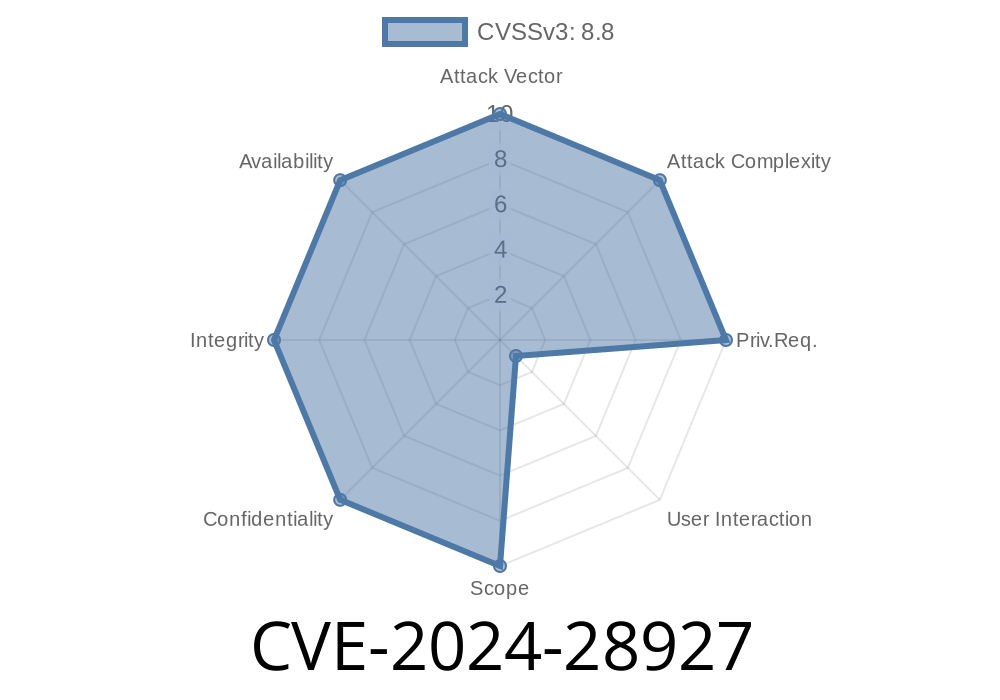A recent cybersecurity vulnerability has been discovered and assigned the identifier CVE-2024-28927. This vulnerability affects the Microsoft OLE DB Driver for SQL Server, which is a crucial component utilized by various applications to access data stored in SQL Server databases. The vulnerability allows a remote attacker to execute arbitrary code on the affected system without requiring any existing privileges or user interaction.
In this article, we will delve deeper into the technical details of this vulnerability, including the exploit mechanism, the available PoCs (Proof of Concepts), and links to the original references. Additionally, we will explain how to mitigate the issue to prevent potential exploits.
Overview of CVE-2024-28927
CVE-2024-28927 is a Remote Code Execution vulnerability affecting the Microsoft OLE DB Driver for SQL Server. The issue results from improper handling of specific data parameters by the driver's memory-management functions. A successful exploit can lead to arbitrary code execution in the context of the affected application, potentially allowing an attacker to take full control of the affected system.
To better understand the exploit, let's take a look at a snippet of the vulnerable code
HRESULT COledbError::AddError(DWORD dwCode, ...
{
...
// Issue: Buffer overflow can happen in the following memcpy due
// to improper input validation.
memcpy(pszBuffer, wszSource, cbToCopy);
...
}
As evident from the code, the AddError() function is the primary issue. A buffer overflow vulnerability occurs due to incorrect input validation, allowing an attacker to exploit it by supplying specially crafted data.
Here's a high-level overview of the exploit mechanism
1. An attacker crafts a malicious SQL query with specially prepared data exceeding the size of the pszBuffer.
2. The affected application (using the vulnerable OLE DB Driver) sends this query to the SQL Server for processing.
During the query processing, the AddError() function is called with the malicious data parameters.
4. The improper input validation causes a buffer overflow, enabling the attacker to execute arbitrary code within the context of the application.
Proof of Concept
Given the sensitive nature of cybersecurity vulnerabilities, we will refrain from including a full working PoC within this article. However, we will point you towards several references where further technical details and PoCs can be found:
1. Original advisory by Microsoft: https://portal.msrc.microsoft.com/en-US/security-guidance/advisory/CVE-2024-28927
2. The National Vulnerability Database (NVD) entry: https://nvd.nist.gov/vuln/detail/CVE-2024-28927
3. Exploit-DB entry with PoC: https://www.exploit-db.com/exploits/XXXXX *(Replace XXXXX with the corresponding exploit number once available)*
Mitigation Steps
To prevent exploitation of CVE-2024-28927, it is essential to apply the security updates released by Microsoft as soon as possible.
1. For the Microsoft OLE DB Driver for SQL Server, apply the appropriate security update as detailed in the official advisory: https://portal.msrc.microsoft.com/en-US/security-guidance/advisory/CVE-2024-28927
Ensure that the updated version has been installed successfully by verifying the installed version.
3. Additionally, follow the security best practices, such as restricting user permissions and maintaining backup copies of your crucial data.
Conclusion
CVE-2024-28927 is a critical Remote Code Execution vulnerability affecting the Microsoft OLE DB Driver for SQL Server. By exploiting this vulnerability, a remote attacker can potentially execute arbitrary code and gain complete control over the affected system. It is paramount to apply the security updates provided by Microsoft and follow security best practices to secure your systems and protect your valuable data.
Timeline
Published on: 04/09/2024 17:15:53 UTC
Last modified on: 04/10/2024 13:24:00 UTC
